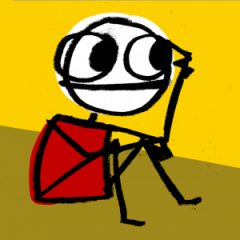Leaderboard
Popular Content
Showing content with the highest reputation on 10/29/15 in Blog Entries
-
How do you eat an entire whale? One bite at a time. Preferably with Cholula. How do you edit/translate/whatever a visual novel? One line at a time. Preferably with bourbon. Whether you’re a fan of the final product or not, one of the things that impresses me most about MDZ’s fan translation of Koisuru Natsu no Last Resort is that it got released, period. As in, if you were so inclined, you could download the installer right now, patch the original Japanese game, and go play the thing on your new-fangled Windows Pee-Cee. No demos, no one-route partial patches. The whole damned VN in English, finished on schedule and out there in the world. The project didn’t stall. It didn’t wind up in no-updates-in-six-months-but-we-think-they’re-still-working-on-it hell. It didn’t climb into that white panel van with Little Busters EX, never to be heard from again. The nice man was lying to you, Little Busters EX — there were no cute little puppies in the back. What were you thinking?! The KoiRizo team did nothing particularly special to make this happen. We just ate the whale one bite at a time. The rhythm method By his own account, MDZ worked very methodically on the project, spending an average of 30 minutes every day translating scripts into English. Not when he felt like it. Not when inspiration struck. Not when enough people harassed him with all-caps emails asking why the HELL hadn’t there been any progress updates on the KoiRizo tracker lately. He made it an expected part of his routine, like brushing his teeth or eating dinner. He scheduled regular translation sessions between classes or before heading out in the morning. He did a little bit. Every. Single. Day. There’s a word for that: consistency. That’s what gets things done in the real world, not 48-hour marathons every random.randint(1,6) weekends fueled by Red Bull, Hot Pockets, and intense self-loathing. Consistency keeps you from getting burned out. Consistency lets you make reasonable schedules and estimates, then stick to them. Consistency is like goddamned black magic. Over the course of the project, MDZ had consistency in spades. If he can maintain that approach to life, I have a feeling he’ll be successful at whatever he puts his mind to after college. When I came on board as an editor, I kept a somewhat similar schedule. I resolved to set aside my commuting time each workday for editing. And so for 40 minutes in the morning and 40 minutes in the evening, Monday through Friday, I’d park my butt in a train seat, break out my laptop, and just edit. Weekdays were reserved for my family. If you’re married with kids, you know there is no such thing as free time on weekends. If you’re not married and don’t have kids, please tell me what the outside world is like. I hear they came out with a PlayStation 2? That’s gotta be pretty awesome. Anyway, that’s what I ended up doing. Edit every single workday. For six months. Until it was done. (Six months? That long to edit a medium-length visual novel? Yeah, that long. KoiRizo weighs in at 36,000+ lines. Over six months, that works out to about 1,400 lines a week, or 210 lines per hour. That’s an edited line every 17 seconds or so, with most of the lines needing substantial polishing/rewriting. I have no idea what pace other VN editors work at, but I felt like this was one I could maintain over the long haul. Call it the distance runner’s lope.) Special topics in calamity physics So why all this rambling about whales and consistency? Because I just got back from vacation a few days ago and I’ve been surprised at how long it’s taken me to get my head back into the various projects I’ve been working on (or even writing this blog). And then I got to wondering how often something small like that snowballs into a stalled or even failed project. A missed day turns into a skipped week turns into a skipped month turns into a dead translation. Which then got me thinking about the coefficient of friction. It’s basic physics, which I excelled at (failing repeatedly). In layman’s terms, it’s a ratio (μ) that gives you a sense how much force two surfaces exert on each other and, therefore, how much force you need to exert to get something moving from a dead stop. Wooden block on ice? Low coefficient of friction. Wooden block on shag carpet? High coefficient of friction ... and a senseless crime against tasteful décor. Once you overcome that initial friction, it takes comparatively little force to keep an object in motion. I can easily imagine there’s a coefficient of friction between us and our work, some quantifiable level of resistance that needs be overcome before we get our asses in gear and be productive. And unlike the one in Physics 101, which is constant for any two materials, this one is different every single day. It depends on a bunch of different factors: how interested we are in our projects, how appreciated we feel, what other projects we’ve got going on at the same time, how much sleep we’ve gotten, what else is going on in our lives, whether or not the Mets are currently in the World Series, etc. Let’s call it the coefficient of slackitude. Once we get started on a project and make it part of our everyday routine, we can largely ignore this number. We’ve overcome the initial slackitude and, with moderate effort, can keep things rolling along fairly smoothly. But each time we let things coast to a stop, even for a few days, we’ve got to overcome the slackitude all over again. And since that value is variable, it might be much harder the second time around. In fact, it probably will be. Eventually, we’ll fail to do so. And our project will die. The takeaway So other than the fact that I had no business being anywhere near a physics classroom, what can we take away from my incoherent ramblings? A couple things: The easiest way to make sure your project gets finished is to stick to a regular schedule. Eat the whale a little at a time — every day if you can. Minimize the gaps. Avoid having to face off against that nasty coefficient of slackitude more than once.The easiest way to make sure your project gets started at all is to pick a time when that coefficient of slackitude is low — when you’re excited by the prospect, when you’re well-rested, when you have relatively few competing interests. When you can focus. Use that time to build your momentum, so when your interest wanes or real life intrudes — it always does and it always will — the project is so embedded in your routine that you can just ride it out.We need more finished translations in the world. So pull up a chair and eat your whale. Do it for your team. Do it for yourself. Do it for poor Little Busters EX, drugged and ball-gagged in a basement somewhere, forever wondering when it’ll finally get to see the puppies.2 points
-
Due to work and school, I haven't been able to progress as much as I would have liked with this VN, but I have gotten moderately far, so I'll give you a bit of an update on my experiences. Gameplay Comments First, the gameplay... this is a straight strategy rpg in format, but it does have a few twists. First, the characters known as 'mech-people' and 'sword-people' can become what their name is... literally becoming a mech or a sword, through their pact with a particular character. In the case of the mech-people, this not only creates a more powerful unit to stand on the field, it also extends their attack range, making them more effective on the battlefield, both offensively and defensively (though at the cost of skills the mech can use being lower level and fewer in number than the characters in question). In opposition, the sword-people directly enhance the stats of their partner, giving them wider movement range, more powerful attacks, stronger defenses, etc. When joined with someone, both sides gain a precise fraction of the experience they would have otherwise gained (in the case of the Kai/Alfaria/Beldadia combo It gets split three ways, for instance). This has some advantages and more disadvantages. The advantage is both characters can get experience from killing enemies... but this advantage is weakened significantly by the fact that characters that join in a group combo generally get more experience than the two joined characters, making it a trade-off for grinding. Speaking of grinding... this game's experience-gaining is a huge pain in the butt, not the least of which because the enemies do massive level jumps (think two to five levels per battle), which makes it a serious pain to keep up, since your levels don't gain fast enough to make leveling anything other than a grind (you can replay any battle at any time on the world map). Another huge downside of this game... Alfaria is pathetically weak when not transformed, but Kai is actually more powerful on foot, at least midway through the game. This makes using the mechform usually not worth it for these two, except for the enhanced hp, but it does make it necessary, because Alfaria dying is usually a game over. Story and Characters So far, I'm still on Kai's side of the story, so I think it is going to be a while before I switch over to Shizuma. I'm going to be blunt... Alfaria feels a lot like a weaker, more naive version of Corona from Corona. She's basically a little kid in an adult's body, with a little kid's thought patterns. This is understandable in the context of the story, but it can be pretty annoying. Kai is pretty much your typical rpg protagonist... right down to the naivete and impulsiveness. To be honest, that irritated the hell out of me at first, though it has subsided somewhat as the story goes on (though he still has bursts of insanity where he does something unbelievably stupid). I chose Beldadia as my first playthrough heroine, and she is fairly interesting, not to mention she is a returning character from Yumina and Corona, a heroine for the first time in this one. I thought about spoiling her here, but lets just say that this VN puts her more in the spotlight this time around and let it go at that. The story in this VN is actually pretty good, in typical VN fashion... why do I say typical? Because in many ways, this story reminds me of why I generally go to VN hybrids more than actual srpgs and rpgs nowadays. Why? It is pretty simple... no taboo subjects. The story is dark, it is violent, and the characters make mistakes that actually get people killed in large numbers. Today's jrpgs tend to avoid things like death, except in the abstract, and as a result, their stories tend to... suck. Yes, I said it. Modern jrpgs suck donkey tits. The rare exceptions just prove the rule, rather than proving it wrong. That said, I don't know if I approve of them putting multiple protagonists in this story, especially considering the number of times the two protagonists end up clashing (it kind of feels like they are ruining the plot, to me). I'll have to see what it is like when I get to Shizuma's part before I decide if I can forgive them for committing the cardinal sin of a serious VN. Well, that's it for now... cheers!2 points



